Daikon
Radish
Raphanus sativus L.
Daikon Radish has bright cream-white stems and vibrant olive-green cotyledons. Like regular radish, Daikon has a crunchy mild radish flavor, perfect for meals that need that extra kick of flavor.
Quick Grow Info:
-
Scientific Name: Raphanus sativus L. var. longipinnatus
-
Flavor: Mild Pungent, Piquant Flavor
-
Seed Rate: 25g-30g per 10″ x 20″ tray
-
Seeds Per in2: 0.125g-0.15g
-
Pre-Soak: No
-
Weight Duration: 2-3 Days
-
Germination Time: 2-3 Days
-
Blackout Time: 1-2 Days
-
Seed To Harvest: 5-7 Days
-
Growing Difficulty: Easy
Did You Know
Fun Fact

Manda Fermentation Co., Ltd. (Japan) grew the world’s heaviest radish, weighing in at 45.865 kg (101 lb 1.8 oz). They set the Guinness world record on 22 February 2023 at HAKKO Park in Onomichi, Hiroshima, Japan.
Plant Details &
Grow Guide
Growing Daikon Radish Microgreens
Radish is a very popular fast growing microgreen, and Daikon Radish is no exception. It’s ready for harvest in only 6 days but you can grow them for longer depending on your preferred flavor profile.
The succulent mild pungent flavor is perfect for many dishes such as sandwiches, salads, stirfries, or as a garnish. It’s a fantastic microgreen for beginners with a short growth period. Let’s get started!
Step 1 Measuring & Preparing Your Daikon Seeds
First, you need to measure your seeds using a scale. The best seeding rate for a 10″ × 20″ tray is 25-35 grams. If you plan to grow them in a 10″ × 10″ tray then simply divide the total amount by two, in this case, 12.5-17.5 grams.
If you’re a renegade like me you can just eyeball it without weighing, just make sure that your seeds are approx ⅛-¼” (3-6mm) apart.
Once you’ve measured out your seeds you do not need to wash and pre-soak them. This is because daikon radish seeds are small about 3-4mm in diameter, and wetting them will make it a nightmare to spread them evenly on your growing medium.
Step 2 Sowing Your Seeds
Fill your tray with your preferred medium, it can be soil, potting mix, coco coir, etc, leaving 1-2cm of empty space from the tray edge to the soil level.
Leaving a small space between the tray edge and grow medium helps when it comes to harvesting, minimizing the chance of digging into the medium with your knife.
Mist your medium with a spray bottle so it’s damp but not saturated and finally spread your seeds evenly across the medium making sure they’re evenly spread out. Lastly, mist your seeds so they’re all covered with a fine mist of water.
Step 3 Germination & Weight Period
Grab an empty tray with no holes and place it on top of your sowed seeds. I use a 15lb (6.80kg) paving block for 10″ × 20″ trays or a 7lb (3.17 kg) brick on 10″ × 10″ trays.
This helps the seed radicle to bury into the medium when it emerges. Without weight, the radicles have a tougher time digging into the growing medium.
Keep in mind that the seeds will germinate while they’re covered and weighed down. A lot of people confuse the germination and weight period to be independent of one another and that you add them together, this is incorrect.
The germination time is there to give you an idea by what time the seeds will germinate, but you don’t add the germination time and blackout period together.
While your seeds are germinating and are weighed down you will need to keep your medium moist. You can do this by lightly misting your seeds every 12 hours, once in the morning and once at night.
Step 4 Blackout Time
After 2-3 days of weight period, the seeds should have germinated and the seedlings should now be lifting the tray with the weight in it. It’s now time to remove the weight and start the blackout period.
Take out the weight from your empty tray and flip it upside down to create a blackout dome and place it back over your seeds.
Keeping them in the dark for 1-2 days will force the freshly sprouted seedlings to stretch and search for light allowing them to get some height.
You can now start bottom watering your microgreens. To do this you simply add water to your bottom drain tray. I personally add 1 cup of water twice a day (every 12 hours), once in the morning and once in the evening.
When the 1-2 days of blackout time have passed you can remove the top tray/blackout dome and introduce your microgreens to light. I’ve found that 17 hours under lights and 7 hours with the lights off work well for me.
Grow your daikon radish anywhere from 5-7 days, following with daily watering of 2 cups per day, once every 12 hours.
Step 5 Harvest
Harvesting your daikon microgreens is straightforward that only requires a sharp tool. Personally, I absolutely love using the Green Mercer Produce Knife—I highly recommend it! But if you prefer scissors, that’s also completely fine; just make sure they’re sharp!
Now, here’s an important tip to keep your harvest pristine; make sure to keep your chosen tool (whether it’s a knife or scissors) away from the soil! It’s imperative in avoiding any accidental contact between the blade and the soil, you don’t want any unwanted dirt from sneaking into your microgreen harvest and contaminating it.
By following this important pointer, you’ll ensure that your harvested microgreens are of top notch quality and purity.
Plant Details & Taxonomy
Daikon is a type of radish that is originally from Japan.
Its name comes from the Japanese words “dai” which means “large” and “kon” which means “root“.
It is an upright plant that grows annually or biennially and has a large white napiform root.
The seeds of daikon radish are relatively light, with a weight range of 90-140 seeds per gram.
Daikon is considered one of the easiest and fastest-growing varieties of microgreens, making it a perfect choice for beginners who want to start growing their own produce.
It requires relatively low maintenance and is easy to care for.
Daikon microgreens have a fresh, crispy, and pungent flavor, which makes them an excellent addition to salads that need a peppery kick or sandwiches that need a bit of crunch!
| Rank | Scientific Name |
| Kingdom | Plantae – Plants |
| Subkingdom | Tracheobionta – Vascular plants |
| Superdivision | Spermatophyta – Seed plants |
| Division | Magnoliophyta – Flowering plants |
| Class | Magnoliopsida – Dicotyledons |
| Subclass | Dilleniidae |
| Order | Capparales |
| Family | Brassicaceae – Mustard family |
| Genus | Raphanus L. – radish |
| Species | Raphanus sativus L. – cultivated radish |
| Variety | Raphanus sativus var. longipinnatus |
| Common Names | Daikon, Daikon Radish, Mooli, White Radish, Winter Radish, Oriental Radish, Long White Radish, Japanese Radish, Chinese White Radish, Icicle Radish, Oilseed Radish |
Microgreen Pests & Diseases
The following are the most common pests and diseases that can affect your microgreens.
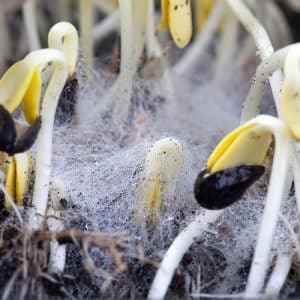
White Mold – Sclerotinia sclerotiorum
Sclerotinia sclerotiorum is a necrotrophic fungal disease that causes what’s known as white mold, it can infect over 400 plant species worldwide. It’s also called cottony soft rot, stem rot, watery soft rot, crown rot, and seedling blight.
S. sclerotiorum key properties are its ability to create sclerotia which are its black resting structures, and mycelium which are the white fuzzy spiderweb-like growths you see on stems and growing medium.
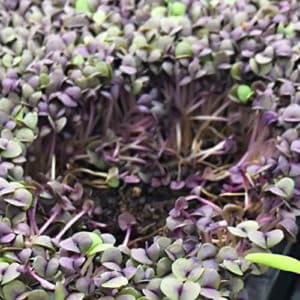
Damping Off
Damping-off is an umbrella term that covers fungi and fungi-like organisms in several genera including Rhizoctonia, Botrytis, Phytophthora, and Fusarium, with the soil fungus Pythium being the often culprit.
Damping-off is a soil-borne fungal disease that affects seeds and seedlings typically by rotting of the stems and roots at and below the soil surface.
When a seed germinates the seedling will emerge fine but within 24 hours to a few days will become mushy and water-soaked, collapse at the base of the stem and die.
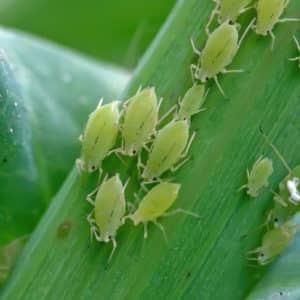
Aphids – Aphidoidea
Aphids suck! Quite literally. They’re soft-bodied insects that use their piercing-sucking mouths to feed on plants and there are over 4,000 aphid species in the world.
Other common names are greenflies, blackflies, and plant lice. They come in varying colors such as light green, black, white, brown, gray, or yellow.
When aphids feed on plants they secrete a sticky fluid which is called honeydew (no, don’t eat it). This goo they leave behind drips onto plants and can attract other pests such as ants. If the honeydew is left on leaves it can promote black sooty mold.
Daikon Radish Nutrition Facts
Daikon radish microgreens are a low-calorie option with only 18 Kcal per serving.
They are a good source of carbohydrates (3% RDA), protein (1% RDA), and dietary fiber (4% RDA).
They provide essential vitamins such as Vitamin C (24% RDA) and Vitamin K, as well as minerals including potassium and calcium.
Additionally, they contain trace amounts of copper, iron, and zinc.
Daikon radish microgreens can add a mild peppery flavor to your meals.
| Principle | Nutrient Value | Unit | RDA |
| Energy | 18 | Kcal | 1% |
| Carbohydrates | 4.1 | g | 3% |
| Protein | 0.6 | g | 1% |
| Total Fat | 0.1 | g | 0% |
| Cholesterol | 0 | mg | 0% |
| Dietary Fiber | 1.6 | g | 4% |
| Vitamins | |||
| Choline | 7.3 | mg | 1% |
| Folate | 28 | µg | 7% |
| Selenium, Se | 0.7 | µg | 1% |
| Vitamin A | 0 | µg | 0% |
| Vitamin B1 (Thiamin) | 0.02 | mg | 2% |
| Vitamin B2 (Riboflavin) | 0.02 | mg | 2% |
| Vitamin B3 (Niacin) | 0.2 | mg | 1% |
| Vitamin B-6 (Pyridoxin) | 0.046 | mg | 4% |
| Vitamin C | 22 | mg | 24% |
| Vitamin E | 0 | mg | 0% |
| Vitamin K | 0.3 | µg | 0% |
| Electrolytes | |||
| Sodium, Na | 21 | mg | 1.40% |
| Potassium, K | 227 | mg | 4.83% |
| Minerals | |||
| Calcium, Ca | 27 | mg | 2.70% |
| Copper, Cu | 0.115 | mg | 12.78% |
| Iron, Fe | 0.4 | mg | 5.00% |
| Magnesium, Mg | 16 | mg | 3.90% |
| Manganese, Mn | 0.038 | mg | 1.65% |
| Phosphorus, P | 23 | mg | 3.29% |
| Zinc, Zn | 0.15 | mg | 1.36% |
| Phytonutrients | |||
| β-Carotene, beta | 0 | µg | 0.00% |
| α-Carotene, alpha | 0 | µg | 0.00% |
| Lutein + zeaxanthin | 0 | µg | 0.00% |
Recommended Products
Explore my top curated picks for products needed to grow microgreens. Rest assured that all the featured items and products have been meticulously put to the test by me or have received glowing recommendations from my esteemed readers.
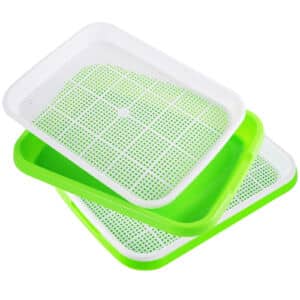
Microgreen Grow Trays
For my personal home use, these microgreen trays are my go to. Measuring around 12.2 x 9.06 x 1.77 inches (31 x 23 x 4.5 cm), these trays are perfectly suited for cultivating microgreens in a home microgreen grow room. What’s more, they’re durable, and cleaning them is a walk in the park, making them an all-around convenient choice.
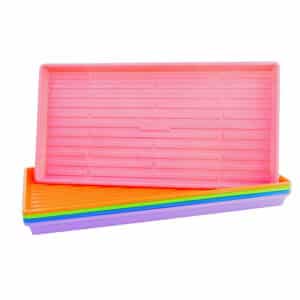
1020 Microgreen Trays – Shallow Extra Strength Colors
Industry leading BootStrap Farmers 1020 microgreen trays! Designed with long lasting durability in mind, these colorful trays are built to withstand years of use and abuse. With a height of 1¼ inches (3.2 cm), these shallow trays make harvests easy, saving you time and increasing your yield. The trays come equipped with 36 drainage holes that effectively remove excess water, promoting a healthy growing environment and preventing mold growth. If you’re serious about growing microgreens and want the best trays available on the market, these trays are it!
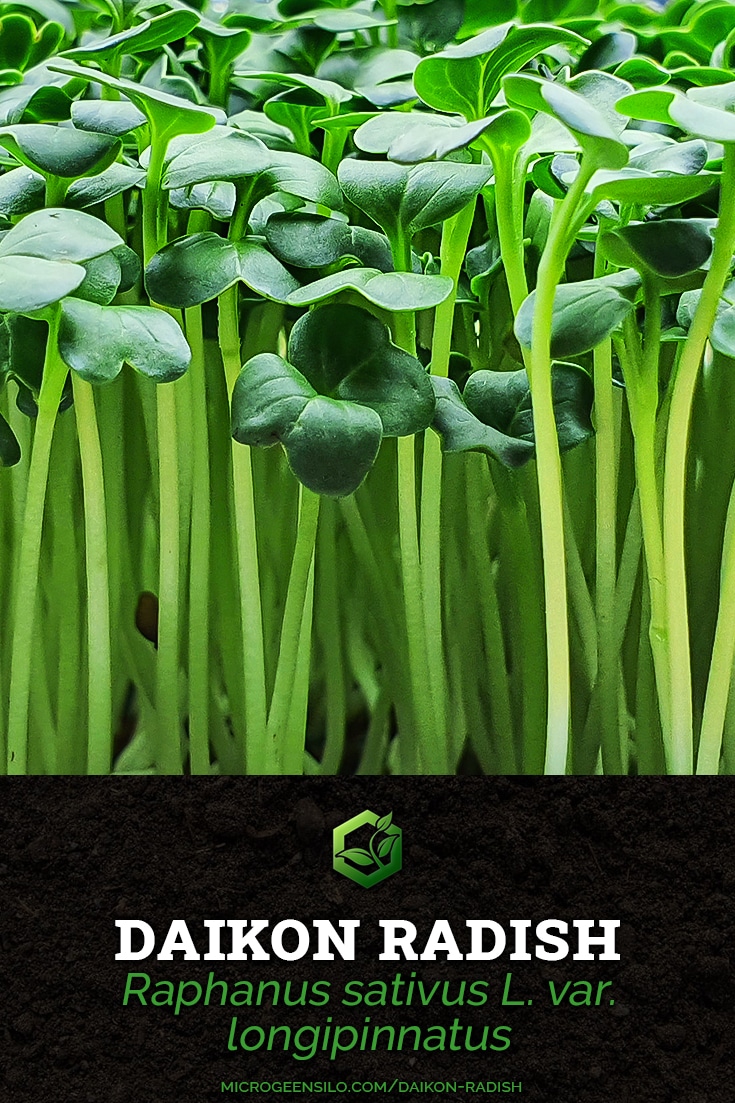
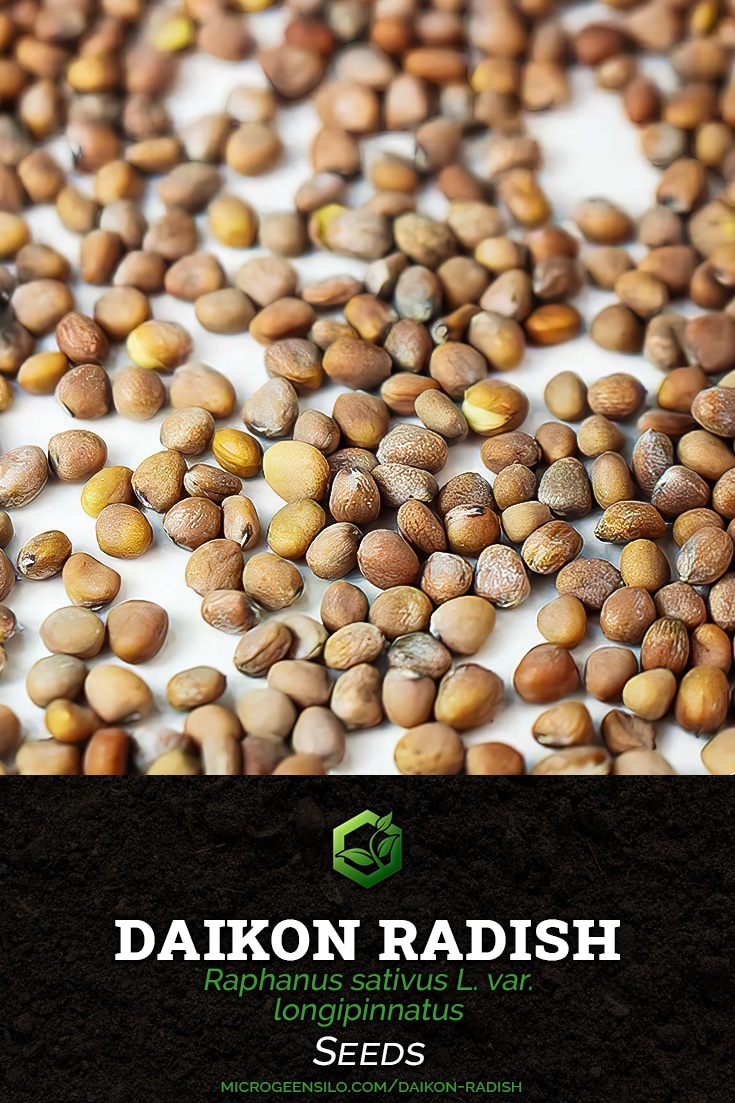


Comments (2)
Hi Milos 🙂 I decided to let a comment for you. I will test it if it is working 🙂 So due my experience with growing daikon radish I know that daikon don’t need to cover with empty tray after germination period. It’s not necessarry.
What I’m doing is that after 3 days of germination I take the weight off in the morning and in the evening I put the tray under the light.
I have less problems with spots on the leaves.
I wanted to share with you my experience.
Have a nice day and keep your hands in the dirt 🙂
Jozef
Hi Jozef, thanks for commenting. Yes, you are correct, you don’t need to leave them in blackout if you don’t want to or if you get better results without the blackout period. Personally, I find the results to be better with a blackout period of 2,3 days than without. But that all comes down to your grow environment, type of lights, ventilation, humidity, and temperature. Hope that helps, and thanks again for commenting and sharing your experience.
Keep Your Hands In The Dirt!